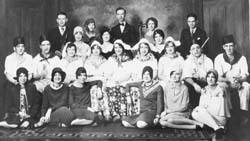
|
Pages: << Back 1 2 3 4 5 6 7 8 9 10 Next >> In place of the faculty as the supreme authority in educational matters was a new body, the senate, composed of the division chairmen and the administrators who were formerly designated as the educational policy committee. Pence and Carson retained their chairmanships, while the retired Post was replaced by Gerhard Baerg, Hughes by Donavan Moffett, Bundy by Fowler D. Brooks, and Smith by Truman Yuncker. It was argued that the new divisional organization would free faculty members from administrative detail and permit them to devote more time and energy to teaching, as well as help create a sense of the interrelatedness of knowledge.
The
new scheme of university governance, imposed in such an arbitrary
manner, proved decidedly unpopular with a large part of the faculty.
Many thought, and some said openly, that the president's actions
were inconsistent with his well known advocacy of democratic social
ideas. After an overwhelming majority of the faculty voted to restore
the former organization, the president relented and in January 1935
asked the trustees to reinstate the powers of the faculty. The departments
once again became the chief instructional units, though the divisions
were retained without any administrative authority as a gesture
in the direction of interdisciplinary cooperation. The faculty proceeded
to reorganize itself according to a plan produced by an informal
committee, with regular monthly meetings and five standing committees.
To four of these committees the faculty elected representatives
nominated by the divisions.
Although
a number of younger professors were dismissed during the early years
of the depression for financial reasons, the Oxnam administration
added many new names to the faculty roster. Included among them
were Hiram M. Stout in political science; Franklin V. Thomas, Laurel
H. Turk, and Marguerite Andrade in Romance languages; Elsie F. Waldo,
George L. Bird, George E. Smock, and T. Carter Harrison in English;
Lucile Calvert in speech; Marion H. Griffitts, G. Hans Grueninger,
Gerhard Baerg, and Edward M.G. Mueller in German; William A. Neiswanger,
Hiram Jome, and Fred Ritchie in economics; Francis M. Vreeland in
sociology; Fowler D. Brooks and Paul J. Fay in psychology; William
Edington in mathematics; Glenn W. Giddings in physics; Albert E.
Reynolds in zoology; Winona H. Welch in botany; Jervis M. Fulmer,
Jesse L. Riebsomer, and Percy
L. Julian in chemistry (the last appointed to a position as
research assistant in lieu of a professorship which the trustees
were not yet ready to grant to a black candidate, no matter how
highly qualified); A. Reid Winsey in art; Vera L. Mintle in home
economics; and Raymond R. Neal, Lloyd L. Messersmith, Willard E.
Umbreit, Martha Taylor (Inglis), and Harold Hickman in physical
education.
_____________________________________
_________________________________
________________________________________
President Oxnam involved the university in a serious controversy over the issue of academic freedom and faculty tenure by refusing in 1933 to renew the contract of Professor Ralph W. Hufferd, a member of the chemistry department since 1920. Hufferd was a highly respected, though admittedly rather tactless, chemistry teacher, as well as an officer in the U.S. Army Reserve, who may have been uncomfortable with Oxnam's pacifist pronouncements. At any rate he incurred the president's displeasure by his outspoken criticism of administration policies and his participation in an interdepartmental quarrel with a division chairman. At his request the American Association of University Professors dispatched a committee to Greencastle to investigate the case. Finding the president uncooperative and the methods of faculty appointment, promotion, and dismissal vague and uncertain, the committee decided to look into the whole system of tenure at the university. Its final report to the executive board of the A.A.U.P. not only condemned Hufferd's dismissal on the grounds of unsubstantiated charges and the lack of any hearing process but also severely criticized President Oxnam's wide, unchecked authority in tenure matters. At its annual meeting in November 1934 the A.A.U.P. voted to remove DePauw University from the "eligible list" of institutions of higher education, a measure amounting to a general censure of the administration. One constructive result of this unfortunate controversy was the adoption by the board of trustees in 1935 of a "Statement of Academic Freedom and Tenure," which belatedly brought the university into compliance with the accepted professional standards of the A.A.U.P. and similar bodies. Whatever his differences with the faculty, President Oxnam was generally popular with the student body. Many former students have attested to his magnetic personality and interesting chapel addresses, to the air of excitement he brought to the quiet and rather isolated campus. His socially prominent wife and active young family also may have contributed to a more sophisticated image of the contemporary Methodist university presidency. It is not altogether clear how much Oxnam's progressive ideas on politics and society may have influenced undergraduates. In the fall of 1932 a straw poll revealed that a large majority of students favored the re-election of Herbert Hoover, a result consistent with the prevailing Republican predilection of the DePauw constituency. More surprisingly, 245 students, cast their ballots for Norman Thomas, the Socialist candidate who had spoken on campus at the president's invitation. After the election of Franklin Roosevelt and the enactment of his New Deal reform measures, the Oxnam administration worked closely with the federal government to help students find employment opportunities on campus. Hundreds of students took advantage of jobs provided through the National Youth Administration and similar agencies to augment their resources in working their way through college.
Despite the economic hard times undergraduates found ways to enjoy the good times associated with the college experience. With the ban on dancing at campus parties lifted by the previous administration, social life flowered in the Oxnam years. DePauw's first Junior Prom took place on May 19, 1930 in Bowman Gymnasium. Formally dressed couples danced to the music of Don Bestor's Victor Recording Orchestra from Pittsburgh in a setting designed to resemble a Japanese garden. Two years later coeds sponsored a Leap Year Ball, which in turn inspired the subsequent annual Gold-Diggers' Ball. In a reversal of roles, women invited men to these dances, furnishing them with ingenious, and sometimes outrageous, corsages and calling for them at their living units. besides such all-campus affairs, the fraternities and sororities each included one formal and one informal dance in the campus social calendar. Interestingly enough, the handful of black males at DePauw held their own annual prom in these years at The Elms, a popular off-campus restaurant, inviting women from Indianapolis and elsewhere as their dancing partners.
_____________________________________ |
Depauw University e-history | E-mail comments to: archives@depauw.edu

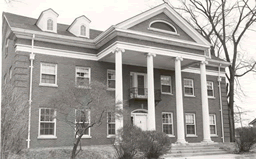 _______________________________________
_______________________________________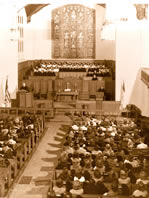
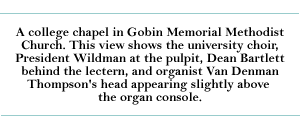
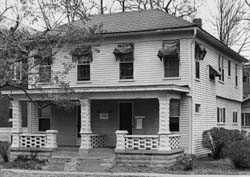
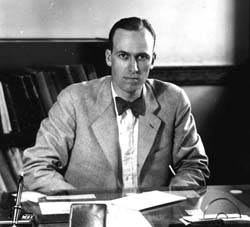
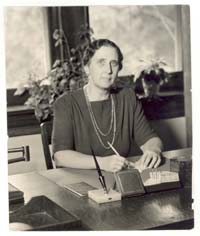
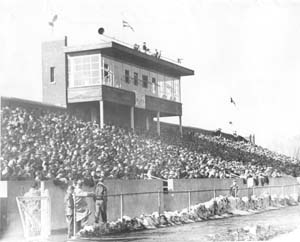 ________________________________
________________________________